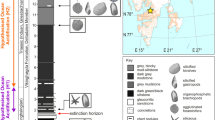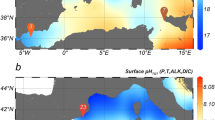Abstract
Increasing atmospheric carbon dioxide levels are causing ocean acidification1,2, compromising the ability of some marine organisms to build and maintain support structures3 as the equilibrium state of inorganic carbon moves away from calcium carbonate4. Few marine organisms tolerate conditions where ocean pH falls significantly below today’s value of about 8.1 and aragonite and calcite saturation values below 1 (refs 5, 6). Here we report dense clusters of the vent mussel Bathymodiolus brevior in natural conditions of pH values between 5.36 and 7.29 on northwest Eifuku volcano, Mariana arc, where liquid carbon dioxide and hydrogen sulphide emerge in a hydrothermal setting. We find that both shell thickness and daily growth increments in shells from northwest Eifuku are only about half those recorded from mussels living in water with pH>7.8. Low pH may therefore also be implicated in metabolic impairment7. We identify four-decade-old mussels, but suggest that the mussels can survive for so long only if their protective shell covering remains intact: crabs that could expose the underlying calcium carbonate to dissolution are absent from this setting. The mussels’ ability to precipitate shells in such low-pH conditions is remarkable. Nevertheless, the vulnerability of molluscs to predators is likely to increase in a future ocean with low pH.
This is a preview of subscription content, access via your institution
Access options
Subscribe to this journal
Receive 12 print issues and online access
$259.00 per year
only $21.58 per issue
Buy this article
- Purchase on Springer Link
- Instant access to full article PDF
Prices may be subject to local taxes which are calculated during checkout




Similar content being viewed by others
References
Orr, J. C. et al. Anthropogenic ocean acidification over the twenty-first century and its impact on calcifying organisms. Nature 437, 681–686 (2005).
Feely, R. A., Sabine, C. L., Hernandez-Ayon, J. M., Ianson, D. & Hales, B. Evidence for upwelling of corrosive ‘acidified’ water onto the continental shelf. Science 320, 1490–1492 (2008).
Fabry, V. J., Seibel, B. A., Feely, R. A. & Orr, J. C. Impacts of ocean acidification on marine fauna and ecosystem processes. ICES J. Mar. Sci. 65, 414–432 (2008).
Feely, R. A. et al. Impact of anthropogenic CO2 on the CaCO3 system in the oceans. Science 305, 362–366 (2004).
Berge, J. A., Bjerkeng, B., Pettersen, O., Schaanning, M. T. & Øxnevad, S. Effects of increased sea water concentrations of CO2 on growth of the bivalve Mytilus edulis L. Chemosphere 62, 681–687 (2006).
Doney, S. C., Fabry, V. J., Feely, R. A. & Kleypas, J. A. Ocean acidification: The other CO2 problem. Annu. Rev. Mar. Sci. 1, 169–192 (2009).
Pörtner, H. O., Langenbuch, M. & Reipschläger, A. Biological impacts of elevated ocean CO2 concentrations: Lessons from animal physiology and earth history? J. Oceanogr. 60, 705–718 (2004).
Iglesias-Rodriguez, M. D. et al. Phytoplankton calcification in a high-CO2 world. Science 320, 336–340 (2008).
Kuffner, I. B., Andersson, A. J., Jokiel, P. L., Rodgers, K. S. & Mackenzie, F. T. Decreased abundance of crustose coralline algae due to ocean acidification. Nature Geosci. 1, 114–117 (2008).
Hall-Spencer, J. M. et al. Volcanic carbon dioxide vents show ecosystem effects of ocean acidification. Nature 454, 96–99 (2008).
von Cosel, R. & Metivier, B. Three new species of Bathymodiolus (Bivalvia: Mytilidae) from hydrothermal vents in the Lau Basin and the North Fiji Basin, Western Pacific, and the Snake Pit area, Mid-Atlantic Ridge. The Veliger 37, 374–392 (1994).
Schöne, B. R. & Giere, O. Growth increments and stable isotope variation in shells of the deep-sea hydrothermal vent bivalve mollusk Bathymodiolus brevior from the North Fiji Basin, Pacific Ocean. Deep-Sea Res. I 52, 1896–1910 (2005).
Embley, R. W. et al. Exploring the Submarine Ring of Fire: Mariana Arc—Western Pacific. Oceanography 20, 68–79 (2007).
Lupton, J. et al. Submarine venting of liquid carbon dioxide on a Mariana Arc volcano. Geochem. Geophys. Geosyst. 7, Q08007 (2006).
Lewis, E. & Wallace, D. W. R. Program Developed for CO2 System Calculations from Carbon Dioxide Information Analysis Center (Oak Ridge National Laboratory, US Department of Energy, 1998).
Kennish, M. J., Tan, A. S. & Lutz, R. A. Shell microstructure of mytilids (Bivalvia) from deep-sea hydrothermal vent and cold-water sulfide–methane seep environments. The Nautilus 112, 84–89 (1998).
Lindinger, M. I., Lauren, D. J. & Mcdonald, D. G. Acid–base balance in the sea mussel Mytilus edulis. III. Effects of environmental hypercapnia on intra- and extracellular acid–base balance. Mar. Biol. Lett. 5, 371–381 (1984).
Michaelidis, B., Ouzounis, C., Paleras, A. & Pörtner, H. O. Effects of long-term moderate hypercapnia on acid–base balance and growth rate in marine mussels Mytilus galloprovincialis. Mar. Ecol. 293, 109–118 (2005).
Bamber, N. R. The effects of acidic sea water on three species of lamellibranch molluscs. J. Exp. Mar. Biol. Ecol. 143, 181–191 (1990).
Lutz, R. A., Fritz, L. W. & Cerrato, R. M. A comparison of bivalve (Calyptogena magnifica) growth at two deep-sea hydrothermal vents in the eastern Pacific. Deep-Sea Res. I 35, 1793–1810 (1988).
Bibby, R., Cleall-Harding, P., Rundle, S., Widdicombe, S. & Spicer, S. Ocean acidification disrupts induced defences in the intertidal gastropod Littorina littorea. Biol. Lett. 3, 699–701 (2007).
Vetter, E. W. & Smith, C. R. Insights into the ecological effects of deep ocean CO2 enrichment: The impacts of natural CO2 venting at Loihi seamount on deep sea scavengers. J. Geophys. Res. 110, C09S13 (2005).
Limén, H. & Juniper, S. K. Habitat controls on vent food webs at NW Eifuku Volcano, Mariana Arc. Cah. Biol. Mar. 47, 449–455 (2006).
Chadwick, W. W. Jr., Scheirer, D. S., Embley, R. W. & Johnson, H. P. High-resolution bathymetric surveys using scanning sonars: Lava flow morphology, hydrothermal vents and geologic structure at recent eruption sites on the Juan de Fuca Ridge. J. Geophys. Res. 106, 16075–16100 (2001).
Butterfield, et al. in The Sub-seafloor Biosphere at Mid-ocean Ridge (eds Wilcock, W. S. D., Kelley, D. S., Baross, J. A., DeLong, E. & Cary, C.) 269–289 (Geophys. Monogr. AGU, 2004).
Yahel, G., Whitney, F., Reiswig, H. M., Eerkes-Medrano, D. I. & Leys, S. P. In situ feeding and metabolism of glass sponges (Hexactinellida, Porifera) studied in a deep temperate fjord with a remotely operated submersible. Limnol. Oceanogr. 52, 428–440 (2007).
Dickson, A. G. & Millero, F. J. A comparison of the equilibrium constants for the dissociation of carbonic acid in seawater media. Deep-Sea Res. I 34, 1733–1743 (1987).
Acknowledgements
We thank the following for help with sample collection: J. Jones, S. K. Juniper, C. Stevens and R. Vrijenhoek. M. Leybourne provided some shipboard water analyses and G. Yahel designed samplers. The operators of the ROVs ROPOS and Jason-II provided field support as did the crews of RVs Thompson, Melville and Sonne. We are grateful for operating permissions from the Kingdom of Tonga and from New Zealand. In the laboratory, we acknowledge the work of S. Merle, K. Roe, N. Buck, D. Eerkes-Medrano and C. Rideout. Expeditions were funded through the NOAA Ocean Exploration Program, the NOAA Vents Program, NSERC Canada and BMBF 03G0192 Project MANGO of Germany. Additional funding to V.T. from the Canada Research Chairs programme is acknowledged.
Author information
Authors and Affiliations
Contributions
All authors were involved with fieldwork or sample analyses. V.T. designed the study and wrote the paper with K.T.A.D. and D.A.B. K.T.A.D. analysed shells, D.A.B. analysed water samples, J.M.R. conducted breakage experiment and set figures and R.W.E. and W.W.C. mapped the volcano summit and edited videos. All authors discussed results and commented on the manuscript.
Corresponding authors
Supplementary information
Supplementary Video S1
Supplementary Information (PDF 1217 kb)
Rights and permissions
About this article
Cite this article
Tunnicliffe, V., Davies, K., Butterfield, D. et al. Survival of mussels in extremely acidic waters on a submarine volcano. Nature Geosci 2, 344–348 (2009). https://doi.org/10.1038/ngeo500
Received:
Accepted:
Published:
Issue Date:
DOI: https://doi.org/10.1038/ngeo500
This article is cited by
-
Early stage ecological communities on artificial algae showed no difference in diversity and abundance under ocean acidification
Hydrobiologia (2023)
-
Bioindicators of severe ocean acidification are absent from the end-Permian mass extinction
Scientific Reports (2022)
-
Plasticity in organic composition maintains biomechanical performance in shells of juvenile scallops exposed to altered temperature and pH conditions
Scientific Reports (2021)
-
Pteropods counter mechanical damage and dissolution through extensive shell repair
Nature Communications (2018)
-
Marine hydrothermal vents as templates for global change scenarios
Hydrobiologia (2018)



